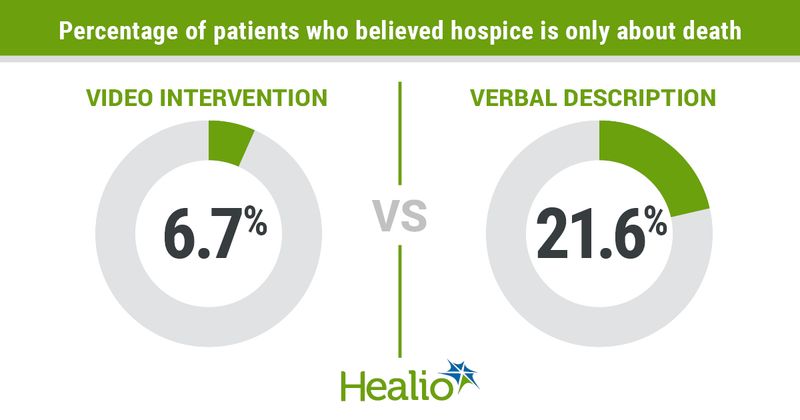Video alters hospice perceptions, but not preferences, among patients with advanced cancer
Viewing a video detailing hospice options did not significantly impact preferences for hospice care among patients with advanced cancer and their caregivers, according to results of a randomized study published in Cancer.
However, patients and caregivers who watched the 6-minute educational video reported greater knowledge and more favorable perceptions of hospice care than those who received a verbal description that matched the content of the video.

In addition, an analysis of study participants who died showed those who watched the video were more likely to use hospice and have longer hospice lengths of stay, results showed.
“These data are compelling, and we should work on future implementation and dissemination trials to replicate these findings across care settings, at multiple institutions,” Areej El-Jawahri, MD, assistant professor of medicine at Massachusetts General Cancer Center and instructor of medicine at Harvard Medical School, told Healio.

“We have always envisioned the use of these videos as part of clinical care, as part of a larger conversation that patients should have with their oncologists about their overall goals," she added. "Therefore, I think integrating these into the context of clinical care at the institution level is the best and most promising strategy for implementation.”
Misperceptions about hospice — including those regarding eligibility, financial coverage, the scope of care provided and the appropriate time to enroll — contribute to its underuse, according to researchers.
El-Jawahri and colleagues sought to increase awareness about hospice by developing an educational video.
The researchers randomly assigned 75 patients with advanced cancer (median age, 62.9 years) and 18 caregivers to watch the video. Another 75 patients (median age, 62.8 years) and 26 caregivers listened to a verbal description identical to the video narrative.
Patient preference for hospice served as the study’s primary endpoint. Patient or caregiver knowledge and perceptions of hospice, as well as overall hospice use, served as secondary endpoints.
Results showed no significant difference between the video intervention and control groups regarding patients’ preferences for hospice (86.7% vs. 82.7%). Patients in the video group, however, reported increased knowledge about hospice (9 vs. 8.4; P = .049) based on a 10-item assessment and were less likely to believe that hospice is only about death (6.7% vs. 21.6%; P = .01).
Among patients who died of advanced cancer during the conduct of the study (n = 136), those who received the video intervention were more likely to have used hospice (85.2% vs. 63.6%; P = .01) and have a longer length of stay in hospice (median, 12 days vs. 3 days; P < .001) than those in the control group.
Among caregivers, those in the video group reported greater knowledge of hospice (9.7% vs. 8%; P = .001). They also appeared more likely to prefer hospice for loved ones (94.4% vs. 65.4%; P = .031) and less likely to believe that hospice is only about death (0% vs. 23.1%; P = .066).
“We need to replicate these findings in a large multisite trial to ensure their generalizability across care settings,” El-Jawahri said. “It is hard to change the standard of care based on an intervention that is done in one relatively small study at one institution. I would advocate for future multisite studies to include a focus on implementation and dissemination so that we think of innovative strategies to integrate this into patient care.”
